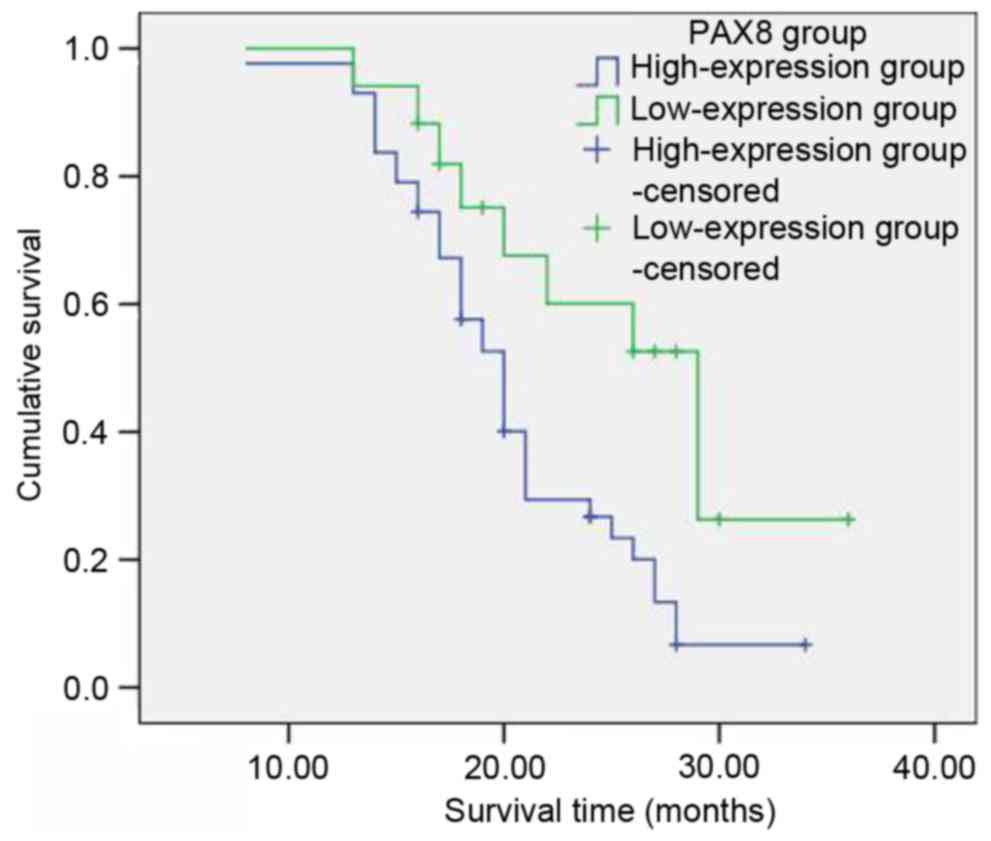|
1
|
Sopik V, Lgbal J, Rosen B and Narod SA:
Why have ovarian cancer mortality rates declined? Part I.
incidence. Gynecol Oncol. 138:741–749. 2015. View Article : Google Scholar : PubMed/NCBI
|
|
2
|
Jemal A, Tiwari RC, Murray T, Ghafoor A,
Samuels A, Ward E, Feuer EJ and Thun MJ: American Cancer Society:
Cancer statistics, 2004. CA Cancer J Clin. 54:8–29. 2004.
View Article : Google Scholar : PubMed/NCBI
|
|
3
|
Morgan RJ Jr, Alvarez RD, Armstrong DK,
Burger RA, Chen LM, Copeland L, Crispens MA, Gershenson DM, Gray
HJ, Hakam A, et al: National comprehensive cancer networks: Ovarian
cancer, version 2.2013. J Natl Compr Canc Netw. 11:1199–1209. 2013.
View Article : Google Scholar : PubMed/NCBI
|
|
4
|
Matias-Guiu X and Davidson B: Prognostic
biomarkers in endometrial and ovarian carcinoma. Virchows Arch.
464:315–331. 2014. View Article : Google Scholar : PubMed/NCBI
|
|
5
|
Horn LC, Einenkel J, Handzel R and Höhn
AK: Morphology of secondary ovarian tumors and metastases.
Pathologe. 35:336–347. 2014.(In German). View Article : Google Scholar : PubMed/NCBI
|
|
6
|
Yonemura Y, Canbay E, Endou Y, Ishibashi
H, Mizumoto A, Miura M, Li Y, Liu Y, Takeshita K, Ichinose M, et
al: Peritoneal cancer treatment. Expert Opin Pharmacother.
15:623–636. 2014. View Article : Google Scholar : PubMed/NCBI
|
|
7
|
Young RH: From krukenberg to today: The
ever present problems posed by metastatic tumors in the ovary: Part
I. Historical perspective, general principles, mutinous tumors
including the krukenberg tumor. Adv Anat Pathol. 13:205–227. 2006.
View Article : Google Scholar : PubMed/NCBI
|
|
8
|
Zhu W and Michael CW: WT1, monoclonal CEA.
TTF1, and CA125 antibodies in the differential diagnosis of lung,
breast, and ovarian adenocarcinomas in serous effusions. Diagn
Cytopathol. 35:370–375. 2007. View
Article : Google Scholar : PubMed/NCBI
|
|
9
|
Lee BH, Hecht JL, Pinkus JL and Pinkus GS:
WT1, estrogen receptor, and progesterone receptor as markers for
breast or ovarian primary sites in metastatic adenocarcinoma to
body fluids. Am J Clin Pathol. 117:745–750. 2002. View Article : Google Scholar : PubMed/NCBI
|
|
10
|
Ozcan A, Steven SS, Hamilton C, Anjana K,
Coffey D, Krishnan B and Truong LD: PAX 8 expression in
non-neoplastic tissues, primary tumors, and metastatic tumors: A
cornprehensive immunohistochemical study. Mod Pathol. 24:751–764.
2011. View Article : Google Scholar : PubMed/NCBI
|
|
11
|
Nonaka D, Chiriboga L and Soslow RA:
Expression of pax8 as a useful marker in distinguishing ovarian
carcinomas from mammary carcinomas. Am J Surg Pathol. 32:1566–1571.
2008. View Article : Google Scholar : PubMed/NCBI
|
|
12
|
Tong GX, Devaraj K, Hamele-Bena D, Yu WM,
Turk A, Chen X, Wright JD and Greenebaum E: PAX8: A marker for
carcinoma of Müllerian origin in serous effusions. Diagn
Cytopathol. 39:567–574. 2011. View
Article : Google Scholar : PubMed/NCBI
|
|
13
|
Mansouri A, Goudreau G and Gruss P: PAX
genes and their role in organogenesis. Cancer Res. 59 7
Suppl:S1707–S1710. 1999.
|
|
14
|
Lang D, Powell SK, Plummer RS, Young KP
and Ruggeri BA: PAX genes: Roles in development, pathophysiology,
and cancer. Biochem Pharmacol. 73:1–14. 2007. View Article : Google Scholar : PubMed/NCBI
|
|
15
|
Plachov D, Chowdhury K, Walther C, Simon
D, Guenet JL and Gruss P: Pax8, a murine paired box gene expressed
in the developing excretory system and thyroid gland. Development.
110:643–651. 1990.PubMed/NCBI
|
|
16
|
Poleev A, Fickenscher H, Mundlos S,
Winterpacht A, Zabel B, Fidler A, Gruss P and Plachov D: PAX8, a
human paired box gene: Isolation and expression in developing
thyroid, kidney and Wilms' tumors. Development. 116:611–623.
1992.PubMed/NCBI
|
|
17
|
Bouchard M, de Caprona D, Busslinger M, Xu
P and Fritzsch B: Pax2 and Pax8 cooperate in mouse inner ear
morphogenesis and innervation. BMC Dev Biol. 10:892010. View Article : Google Scholar : PubMed/NCBI
|
|
18
|
Mittag J, Winterhager E, Bauer K and
Grümmer R: Congenital hypothyroid female pax8-deficient mice are
infertile despite thyroid hormone replacement therapy.
Endocrinology. 148:719–725. 2007. View Article : Google Scholar : PubMed/NCBI
|
|
19
|
Levanon K, Ng V, Piao HY, Zhang Y, Chang
MC, Roh MH, Kindelberger DW, Hirsch MS, Crum CP, Marto JA and
Drapkin R: Primary ex vivo cultures of human fallopian tube
epithelium as a model for serous ovarian carcinogenesis. Oncogene.
29:1103–1113. 2010. View Article : Google Scholar : PubMed/NCBI
|
|
20
|
Vang R, Gown AM, Barry TS, Wheeler DT,
Yemelyanova A, Seidman JD and Ronnett BM: Cytokeratins 7 and 20 in
primary and secondary mucinous tumors of the ovary: Analysis of
coordinate immunohistochemical expression profiles and staining
distribution in 179 cases. Am J Surg Pathol. 30:1130–1139. 2006.
View Article : Google Scholar : PubMed/NCBI
|
|
21
|
Ordóñez NG: Value of PAX 8 immunostaining
in tumor diagnosis: A review and update. Adv Anat Pathol.
19:140–151. 2012. View Article : Google Scholar : PubMed/NCBI
|
|
22
|
Ordóñez NG: Value of PAX8, PAX2,
claudin-4, and h-caldesmon immunostaining in distinguishing
peritoneal epithelioid mesotheliomas from serous carcinomas. Mod
Pathol. 26:553–562. 2013. View Article : Google Scholar : PubMed/NCBI
|
|
23
|
Laury AR, Hornick JL, Perets R, Krane JF,
Corson J, Drapkin R and Hirsch MS: PAX8 reliably distinguishes
ovarian serous tumors from malignant mesothelioma. Am J Surg
Pathol. 34:627–635. 2010.PubMed/NCBI
|












